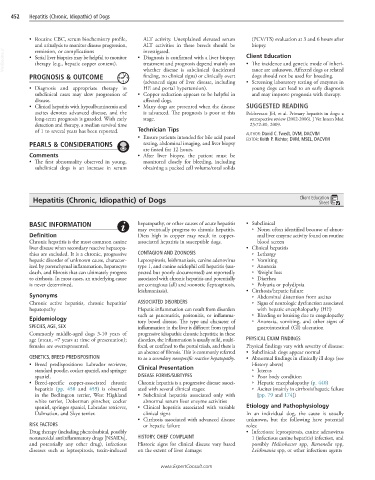Page 923 - Cote clinical veterinary advisor dogs and cats 4th
P. 923
452 Hepatitis (Chronic, Idiopathic) of Dogs
• Routine CBC, serum biochemistry profile, ALT activity. Unexplained elevated serum (PCV/TS) evaluation at 3 and 6 hours after
and urinalysis to monitor disease progression, ALT activities in these breeds should be biopsy.
investigated.
remission, or complications
VetBooks.ir • Serial liver biopsies may be helpful to monitor • Diagnosis is confirmed with a liver biopsy; Client Education
treatment and prognosis depend mainly on
therapy (e.g., hepatic copper content).
• The incidence and genetic mode of inheri-
dogs should not be used for breeding.
finding, no clinical signs) or clinically overt
PROGNOSIS & OUTCOME whether disease is subclinical (incidental tance are unknown. Affected dogs or related
(advanced signs of liver disease, including • Screening laboratory testing of enzymes in
• Diagnosis and appropriate therapy in HE and portal hypertension). young dogs can lead to an early diagnosis
subclinical cases may slow progression of • Copper reduction appears to be helpful in and may improve prognosis with therapy.
disease. affected dogs.
• Clinical hepatitis with hypoalbuminemia and • Many dogs are presented when the disease SUGGESTED READING
ascites denotes advanced disease, and the is advanced. The prognosis is poor at this Poldervaart JH, et al. Primary hepatitis in dogs: a
long-term prognosis is guarded. With early stage. retrospective review (2002-2006). J Vet Intern Med
detection and therapy, a median survival time 23:72-80, 2009.
of 1 to several years has been reported. Technician Tips AUTHOR: David C. Twedt, DVM, DACVIM
• Ensure patients intended for bile acid panel EDITOR: Keith P. Richter, DVM, MSEL, DACVIM
PEARLS & CONSIDERATIONS testing, abdominal imaging, and liver biopsy
are fasted for 12 hours.
Comments • After liver biopsy, the patient must be
• The first abnormality observed in young, monitored closely for bleeding, including
subclinical dogs is an increase in serum obtaining a packed cell volume/total solids
Hepatitis (Chronic, Idiopathic) of Dogs Client Education
Sheet
BASIC INFORMATION hepatopathy, or other causes of acute hepatitis • Subclinical
may eventually progress to chronic hepatitis. ○ None; often identified because of abnor-
Definition Diets high in copper may result in copper- mal liver enzyme activity found on routine
Chronic hepatitis is the most common canine associated hepatitis in susceptible dogs. blood screen
liver disease when secondary reactive hepatopa- • Clinical hepatitis
thies are excluded. It is a chronic, progressive CONTAGION AND ZOONOSIS ○ Lethargy
hepatic disorder of unknown cause, character- Leptospirosis, leishmaniasis, canine adenovirus ○ Vomiting
ized by parenchymal inflammation, hepatocyte type 1, and canine acidophil cell hepatitis (sus- ○ Anorexia
death, and fibrosis that can ultimately progress pected but poorly documented) are reportedly ○ Weight loss
to cirrhosis. In most cases, an underlying cause associated with chronic hepatitis and potentially ○ Diarrhea
is never determined. are contagious (all) and zoonotic (leptospirosis, ○ Polyuria or polydipsia
leishmaniasis). • Cirrhosis/hepatic failure
Synonyms ○ Abdominal distention from ascites
Chronic active hepatitis, chronic hepatitis/ ASSOCIATED DISORDERS ○ Signs of neurologic dysfunction associated
hepatopathy Hepatic inflammation can result from disorders with hepatic encephalopathy (HE)
such as pancreatitis, peritonitis, or inflamma- ○ Bleeding or bruising due to coagulopathy
Epidemiology tory bowel disease. The type and character of ○ Anorexia, vomiting, and other signs of
SPECIES, AGE, SEX inflammation in the liver is different from typical gastrointestinal (GI) ulceration
Commonly middle-aged dogs 3-10 years of progressive idiopathic chronic hepatitis; in these
age (mean, ≈7 years at time of presentation); disorders, the inflammation is usually mild, multi- PHYSICAL EXAM FINDINGS
females are overrepresented. focal, or confined to the portal triads, and there is Physical findings vary with severity of disease:
an absence of fibrosis. This is commonly referred • Subclinical: dogs appear normal
GENETICS, BREED PREDISPOSITION to as a secondary nonspecific reactive hepatopathy. • Abnormal findings in clinically ill dogs (see
• Breed predispositions: Labrador retriever, Clinical Presentation History above)
standard poodle, cocker spaniel, and springer ○ Icterus
spaniel. DISEASE FORMS/SUBTYPES ○ Poor body condition
• Breed-specific copper-associated chronic Chronic hepatitis is a progressive disease associ- ○ Hepatic encephalopathy (p. 440)
hepatitis (pp. 458 and 459) is observed ated with several clinical stages: ○ Ascites (mainly in cirrhosis/hepatic failure
in the Bedlington terrier, West Highland • Subclinical hepatitis associated only with [pp. 79 and 174])
white terrier, Doberman pinscher, cocker abnormal serum liver enzyme activities
spaniel, springer spaniel, Labrador retriever, • Clinical hepatitis associated with variable Etiology and Pathophysiology
Dalmatian, and Skye terrier. clinical signs In an individual dog, the cause is usually
• Cirrhosis associated with advanced disease unknown, but the following have potential
RISK FACTORS or hepatic failure roles:
Drug therapy (including phenobarbital, possibly • Infections: leptospirosis, canine adenovirus
nonsteroidal antiinflammatory drugs [NSAIDs], HISTORY, CHIEF COMPLAINT 1 (infectious canine hepatitis) infection, and
and potentially any other drug), infectious Historic signs for clinical disease vary based possibly Helicobacter spp, Bartonella spp,
diseases such as leptospirosis, toxin-induced on the extent of liver damage: Leishmania spp, or other infectious agents
www.ExpertConsult.com

